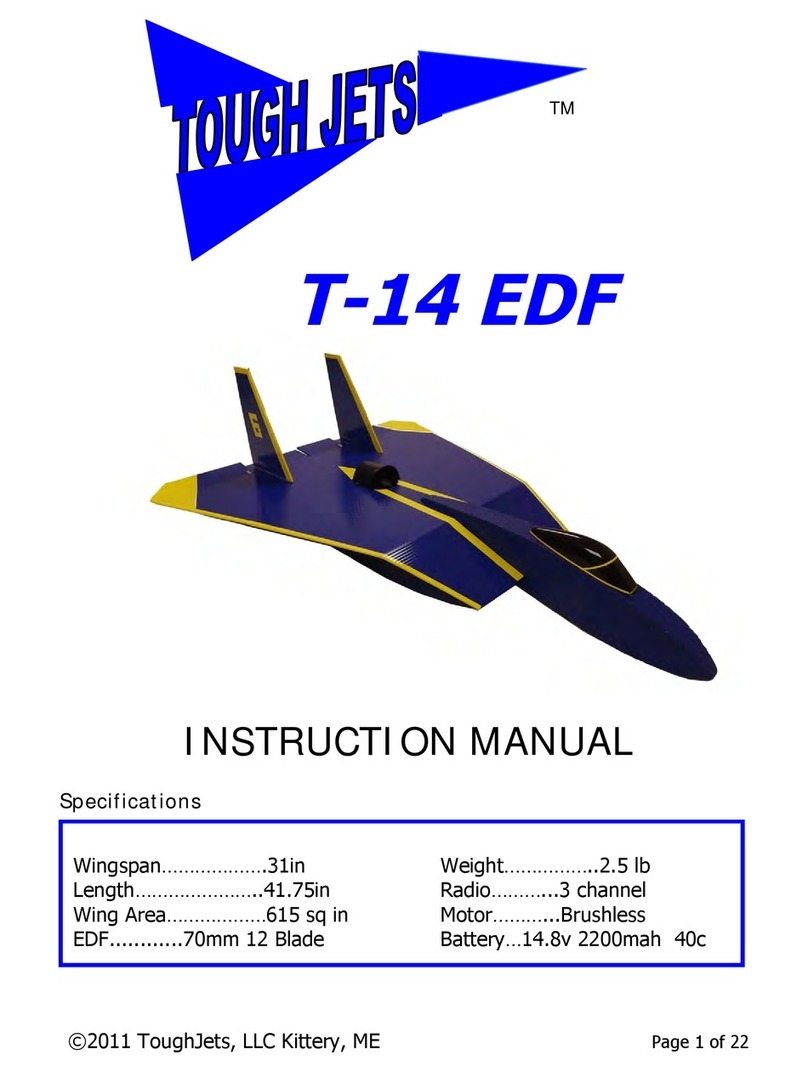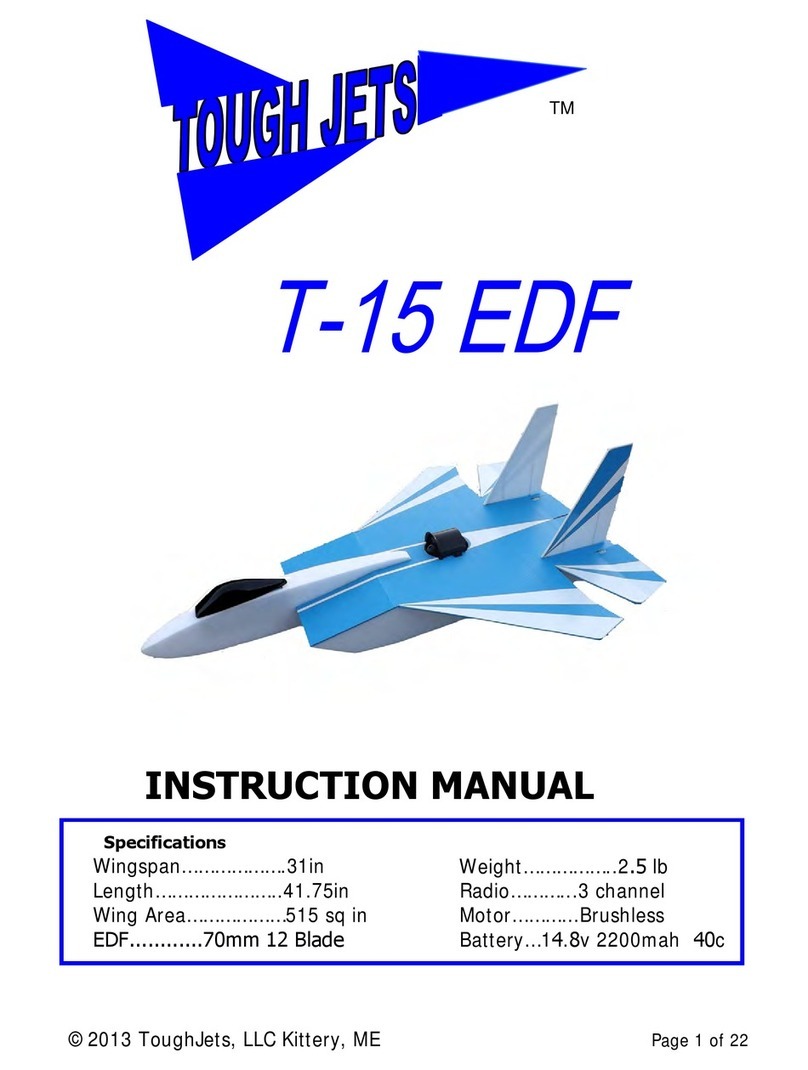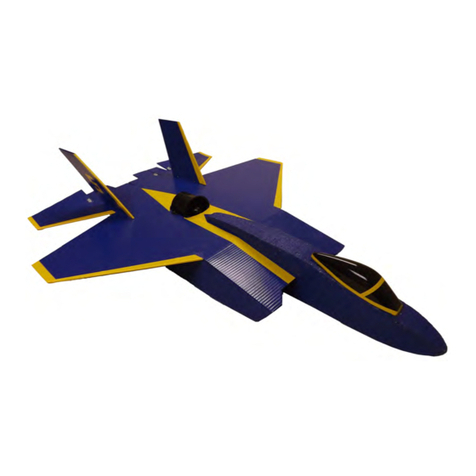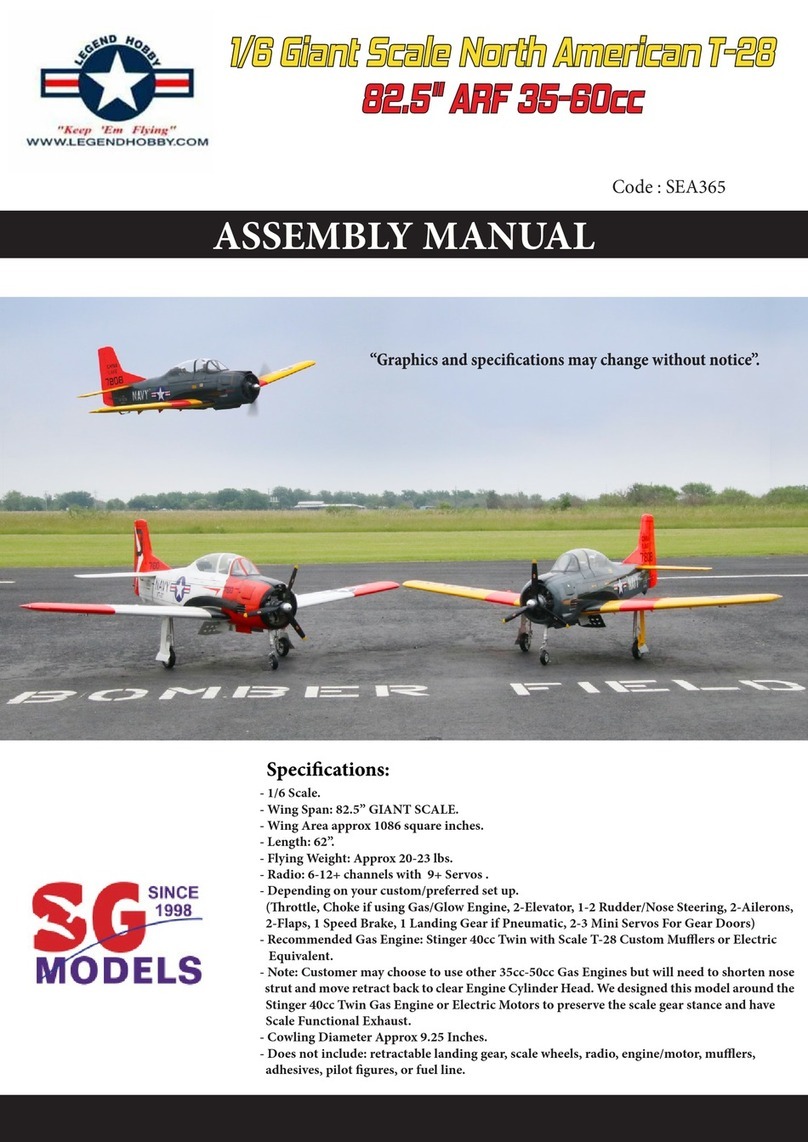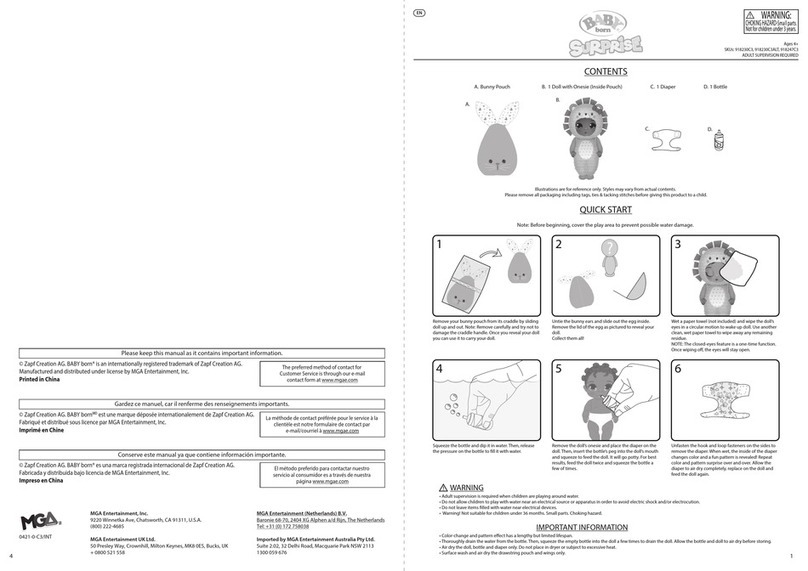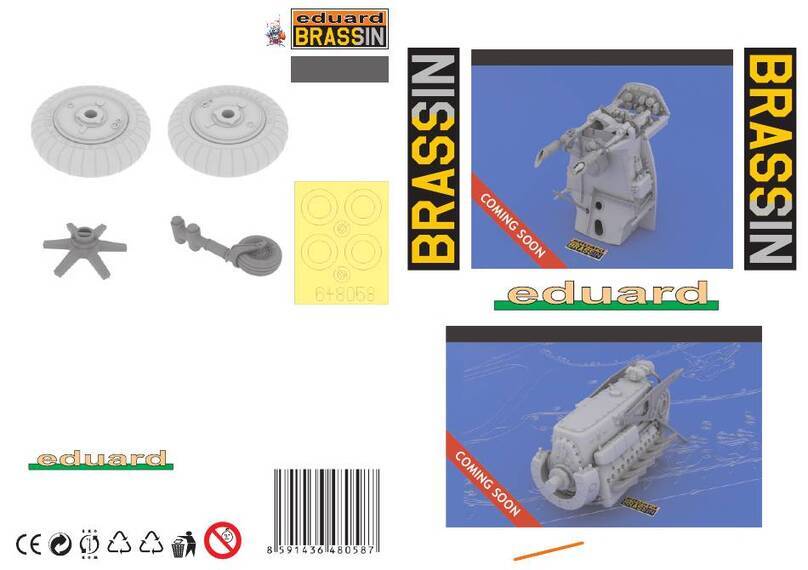Tough Jets T-14 User manual

©2011 ToughJets, LLC Kittery, ME
Page 1 of 22
Wingspan……………….31in Weight……………..2 lb
Length…………………..41.75in Radio………...3 channel
Wing Area………………615 sq in Motor………...Brushless
Propeller…………………9 x 6 Battery…11.1v 2200mah 25c
INSTRUCTION MANUAL
Specifications
T
M

©2011 ToughJets, LLC Kittery, ME
Page 2 of 22
KIT CONTENTS
(1) Wing (4) 3mm X 12mm Bolts
(1) Fuselage (4) 3mm X 14mm Bolts
(2) Nacelles (8) 3mm Lock Nuts
(1) Battery box spacer (4) Flat washers
(2) Vertical stabilizers (2) Control horns, (4) for T-14V
(1) Canopy (2) Clevis, (4) for T-14V
(1) Canopy hinge (2) Push rods, (4) for T-14V
(1) Motor mount (2) Push rod keepers, (4) for T-14V
(2) Rare Earth magnets (1) Coroplast® motor mount stiffener
(2) 14 Gauge wire (4) Wood dowels
(1) Carbon Fiber Shaft 30 inch

©2011 ToughJets, LLC Kittery, ME
Page 3 of 22
BEFORE YOU BUILD
WARNING!!
This kit is not a toy.
This model is intended for the competent builder and RC pilot aged 14
years and older. It is the responsibility of the modeler to ensure the
model is airworthy before attempting to fly it.
Always ensure that any glue, paint or solvents used to build this kit are compatible with the
materials contained in this kit. Some glues and paint can melt Styrofoam and plastic that is
contained in this kit.
Before gluing any parts together, we strongly suggest trial fitting the parts without glue first;
to ensure that all the parts align and fit properly. This will ensure the airplane is built straight
and square.
ABOUT THE TOUGHJETS T-14
The ToughJets T-14 was designed by life-long RC modeler Wayne Roberts to be the highest
performing fun scale RC propjet on the market. You’ll find the T-14 has an enormous flight
envelope. It’s capable of 60+mph, it’s highly aerobatic, yet it lands at near zero ground speed
in the slightest of headwinds.
TOOLS AND SUPPLIES REQUIRED
5 Minute Epoxy Hobby knife
CA glue Wire Cutters
Electric Drill Scissors
Assorted Drill Bits Clear Packaging Tape
Needle nose pliers Pencil
Small screw drivers Rubbing Alcohol
Allen wrench 2.5mm 3M Type 77 Spray Adhesive

©2011 ToughJets, LLC Kittery, ME
Page 4 of 22
ADDITIONAL EQUIPMENT REQUIRED
3 channel radio with mixing (Minimum)
2 micro servos (HI TEC HS-55 or equivalent)
1. 9 inch aileron extension and 1. 18-inch aileron extension wire.
Brushless outrunner motor (BPhobbies # BL-A2814/6 or equivalent)
50 amp electronic speed control
3 cell lipo battery 11.1 volt 2200 mah 25 c
9X6 Master airscrew standard nitro prop (NOTE: not pusher prop)
EXPLODED VIEW
Use this exploded view to help guide you through the assembly of the major components of
your ToughJets T-14

©2011 ToughJets, LLC Kittery, ME
Page 5 of 22
LET’S BEGIN BUILDING
It is strongly suggested you review the drawings, photos and captions to familiarize yourself
with the design and construction of the model.
Before beginning construction, you will want to decide whether to paint or cover the foam
parts with heat shrink film such as EconoKote, or packaging tape. You may also choose to
leave these parts uncovered. If you choose EconoKote, or packaging tape, spray the surfaces
to be covered with 3M Type 77 spray adhesive prior to covering. Allow the adhesive to set for
5 minutes prior to applying the covering, this will improve the overall adhesion of the covering
to the foam. When covering the nacelles, do not apply covering material to the surfaces to be
epoxied to the wing.
It is highly recommended to apply the covering material prior to assembling the
model. Do NOT apply covering to the top edge and slant of the nacelle (see insert)

©2011 ToughJets, LLC Kittery, ME
Page 6 of 22
WING / NACELLE / FUSELAGE ASSEMBLY
Lay wing on a flat surface, bottom side up.
This is the side with the hinge slots and
crease.
Clean the bottom of the wing with rubbing
alcohol before gluing
Apply 5 minute epoxy to top of nacelle on
flat section only. Do not apply epoxy to
slanted section at this time.
Carefully align nacelle with leading edge and
crease on the bottom of the wing.

©2011 ToughJets, LLC Kittery, ME
Page 7 of 22
Ensure the nacelle is parallel and 90 degrees
to prop slot in wing. You have some time to
make slight adjustments before epoxy cures
but move quickly.
Be sure that the nacelle is properly aligned
with crease
Hold the nacelle in place until the five-
minute epoxy cures, check that nacelle is
aligned with leading edge, crease and
centered on Vertical stabilizer dowel holes on
wing.
Repeat the steps to attach the second
nacelle to the wing. Nacelles should be
straight and parallel

©2011 ToughJets, LLC Kittery, ME
Page 8 of 22
Now apply 5-minute epoxy to the slanted
sections on both nacelles. Press both nacelles to leading edge of the
wing applying pressure on a smooth flat
surface for 5 minutes until the e
p
ox
y
cures
Turn the wing over, measure and mark on
the top the center of the wing Apply 5 minute epoxy to both side of
fuselage wing slot. Slide the fuselage onto
the wing. Be sure that the fuselage is
centered straight and square to wing.

©2011 ToughJets, LLC Kittery, ME
Page 9 of 22
Epoxy 2 dowels into the flutes of each
vertical stabilizers. Position the dowels 1½”
and 4 ½” from the trailing edge. Leave
about 1 ½” of dowel exposed
Twist a 1/8-inch drill bit in Vertical stabilizer
dowel holes to clear out foam to for dowels
Place Vertical stabilizer in wing at this time
you can chose to glue in place permanently
or secure with clear packaging tape so you
can remove for transporting model.
Repeat steps for other side. It’s starting to
look like a plane now.

©2011 ToughJets, LLC Kittery, ME
Page 10 of 22
Apply a little 5 minute epoxy to the 3mm
carbon fiber shaft, then insert it in a wing
flute approximately 6 ½ inches behind the
prop slot (see photo)

©2011 ToughJets, LLC Kittery, ME
Page 11 of 22
MOTOR ASSEMBLY
Bolt motor to mount with 3mm x 12mm bolts
included. and attach 9 X 6 propeller. NOTE:
Use a standard 9 X 6 prop facing forward
with motor turning clockwise.
Line up motor and propeller with propeller
slot making sure propeller has equal
clearance around slot and motor is straight
and square. Mark location and drill holes.
Drill holes in motor mount to accommodate
your brushless motor. Drill (4) 1/8 inch holes in mount to attach
mount to wing

©2011 ToughJets, LLC Kittery, ME
Page 12 of 22
Mark and drill holes for motor wires Motor mount and wire holes.
Bolt motor in place on wing using 4. 3mmX
14mm bolts, nuts and washers included.
Prop slot can be trimmed if necessary. (TOP
VIEW
)
Bolt mount through wing and Coroplast®
stiffener don’t over tighten bolts. (BOTTOM
VIEW)

©2011 ToughJets, LLC Kittery, ME
Page 13 of 22
CANOPY / BATTERY BOX ASSEMBLY
Carefully trim the canopy to fit the fusela
g
e. Cut the small piece of Coroplast® to fit the
rear part of the canopy.
Fit the Coroplast® to the canopy. Epoxy the Coroplast® piece and CA glue
canopy hinge into place to the inside of the
canopy, after painting the outside of the
canopy.

©2011 ToughJets, LLC Kittery, ME
Page 14 of 22
Cut a slit ½ “ in front of the battery box for
the canopy hinge.
T
est fit the hin
g
e. Then
g
lue into place.
The hinged canopy will cover the battery
box.
Drill a small hole and glue magnet to the
Coroplast at the rear of the canopy.

©2011 ToughJets, LLC Kittery, ME
Page 15 of 22
RADIO SYSTEM INSTALLATION
It may be necessary to trim the servo-
mounting hole to accommodate the servos. Install the servo into the mounting hole and
glue in place. We recommend HiTec HS-55
or similar type servo.
T
he canopy is now complete.
Drill a hole the same size as the magnet near
the battery box, position it such that it will
align with the magnet on the canopy. Ensure
the polarity of the magnet is such that they
are attracted when the canopy is closed.
Epoxy the magnet in place

©2011 ToughJets, LLC Kittery, ME
Page 16 of 22
Attach the control horn to the right elevon,
don’t over tighten. Measure and cut the push rod to fit between
the servo arm and control horn.
Connect the push rod to the servo arm 2nd
hole from end and control horn middle hole.
Repeat steps for left side.
NOTE: WHEN SERVO IS IN NEUTRAL
POSITION, THERE SHOULD BE APPROX.
5/8” OF UP DEFLECTON ON THE
FLIGHT CONTROLS TO MAINTAIN
LEVEL FLIGHT.
Bend the cut end to accommodate the push
rod keeper.

©2011 ToughJets, LLC Kittery, ME
Page 17 of 22
For the T-14V only. Two more servos are
placed on the inboard side of the nacelles
opposite and above outboard servos as seen
on page 15 and 16.
For the T-14V only. The servos are
connected with Y cords to outboard elevon
servos.
T-14V Thrust Vectoring Flight
Center Elevon Control Surface
Throws
FULL UP: about 1 inch up
NEUTRAL: about 3/32 up
FULL DOWN: about 1/2 inch
down
Outboard Elevon throws for the T-14V are the
same as the T-14. (see page 16, 19 and 21)
Center of gravity is still maintained at 11 ¼” to 11 ½”
from the leading edge of wing add nose weight if necessary.

©2011 ToughJets, LLC Kittery, ME
Page 18 of 22
Servo wire exits on inside of nacelle. Cut slot in right nacelle for servo wire and
extension, single knife cut is sufficient here.
Embed servo wire and extension. Repeat
steps for left side. Cut slot for electronic speed control wires, it
may be necessary to extend you electronic
speed control battery wires in order to reach
battery connector exit. Single knife cut is
sufficient here, then use flat tip screw driver
to open slot.

©2011 ToughJets, LLC Kittery, ME
Page 19 of 22
Embed electronic speed control battery wires
in slot. Use double sided tape to hold speed
control in place.
you can mount your receiver on top
or next to your electronic speed
control as shown in photo
Use servo Y leads to route wires as shown in photo. Onc e wires
are neatly placed they can be taped in place in the slots and to bottom of
wing with clear packaging tape or vinyl tape to match the color of the
wing. Care must be taken that the wires and receiver antenna are do
become entangle or severed by the propeller.

©2011 ToughJets, LLC Kittery, ME
Page 20 of 22
Now you have a complete airplane that can be customized with decals tape or paint
to your liking. You may want to cover the exposed flute holes in the leading edge
of the wing and tail surfaces with tape. This is not necessary and does not affect
the plane’s performance.
NOTE: WHEN ELEVATOR STICK IS IN THE NEUTRAL POSITION THERE
SHOULD BE APPROX. 5/8” OF UP DEFLECTON (OR REFLEX) ON BOTH
FLIGHT CONTROL SURFACES TO MAINTAIN LEVEL FLIGHT.
This manual suits for next models
1
Table of contents
Other Tough Jets Toy manuals
Popular Toy manuals by other brands
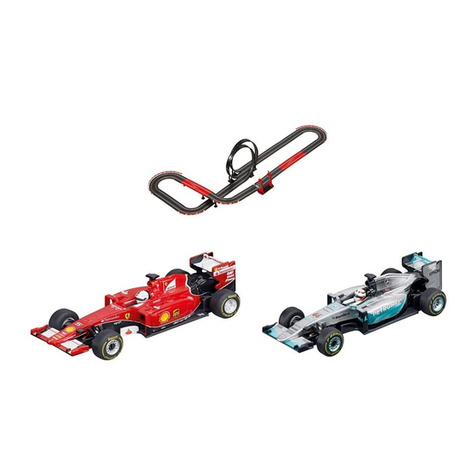
Carrera
Carrera Digital 143 Nascar Assembly and operating instructions

Freewing
Freewing Spirit instruction manual
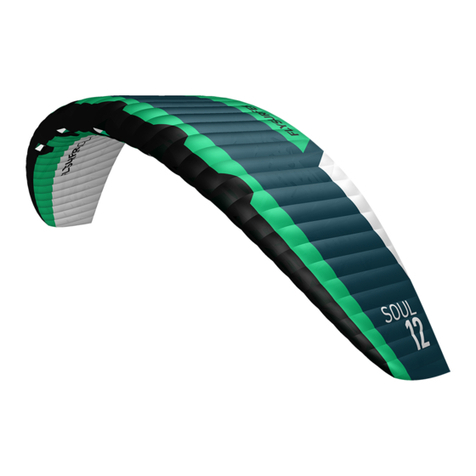
FLYSURFER
FLYSURFER SOUL user manual

VENOM
VENOM Night Ranger II Pilot's handbook

Eduard
Eduard Harrier T.4 exterior installation instructions
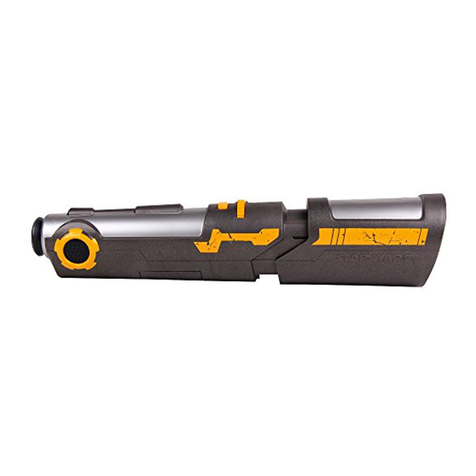
Uncle Milton
Uncle Milton Star Wars Science Jedi Telescope instruction manual

Mattel
Mattel Barbie CLD93 instructions
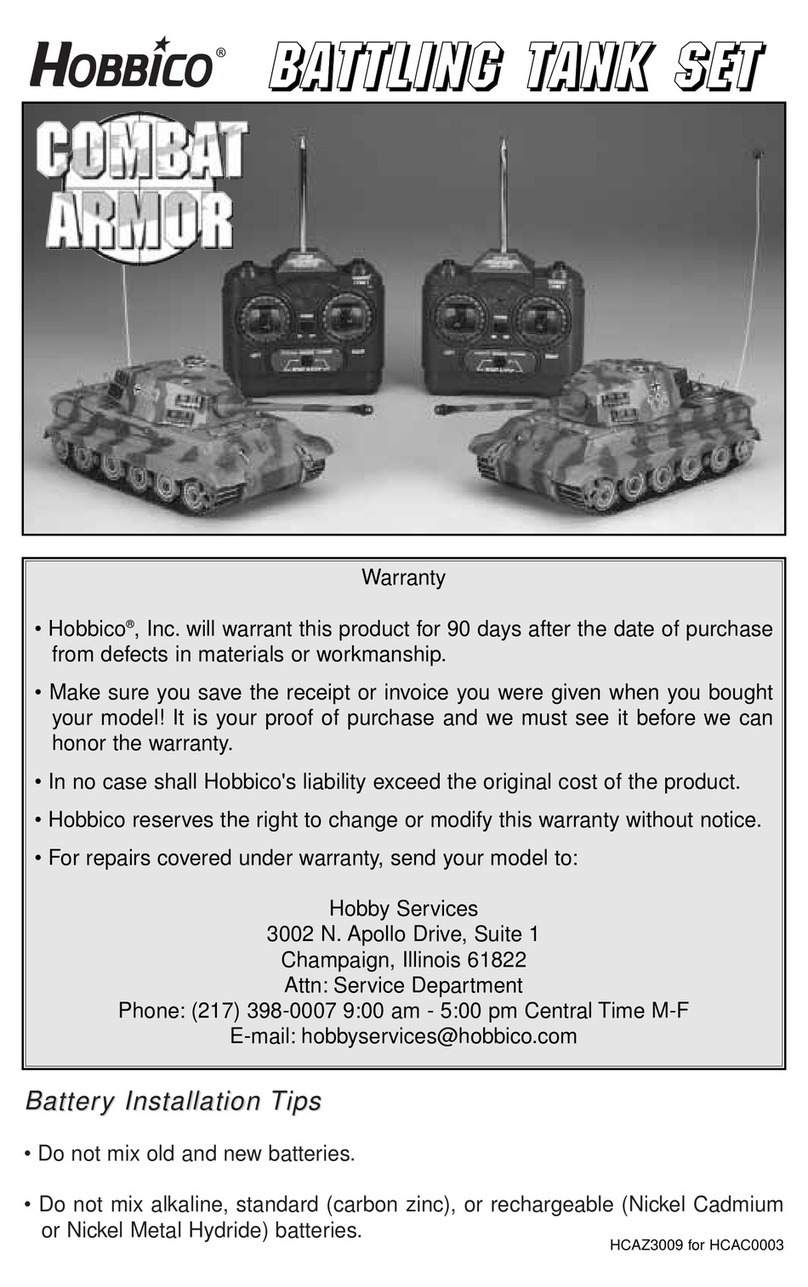
Hobbico
Hobbico Battling Tank Ser manual

Fisher-Price
Fisher-Price SMART CYCLE K5056 user manual
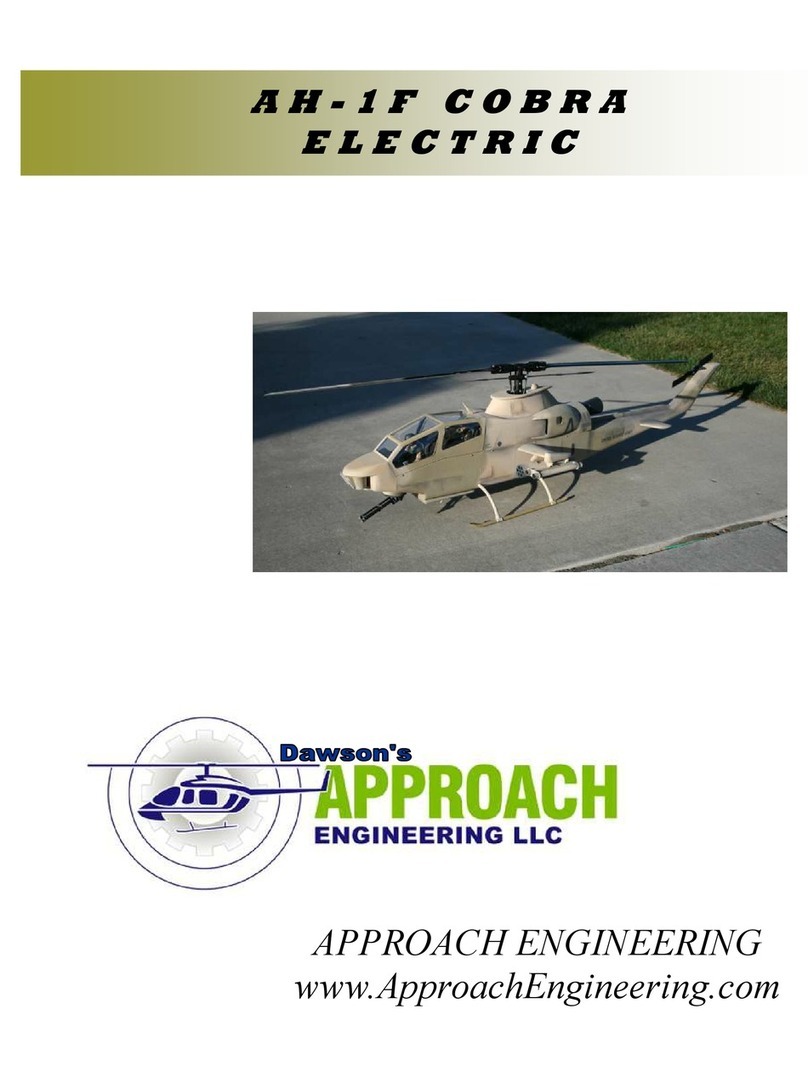
Approach Engineering
Approach Engineering AH-1F Cobra Electric Assembly manual & user guide
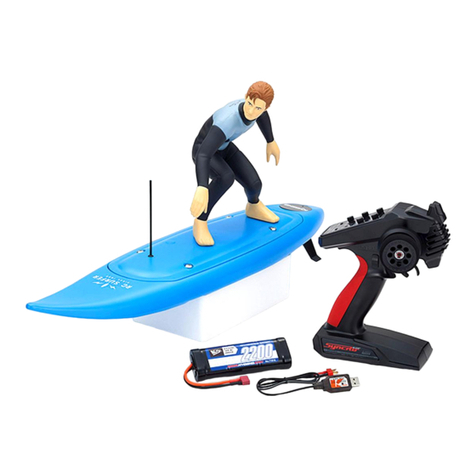
Kyosho
Kyosho RC SURFER instruction manual

Little Tikes
Little Tikes First OVEN manual
